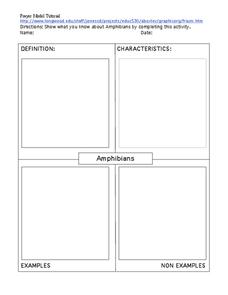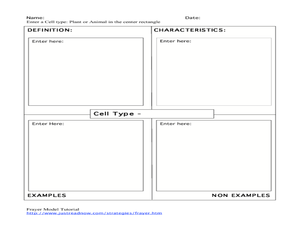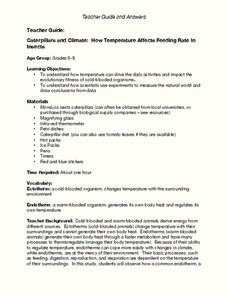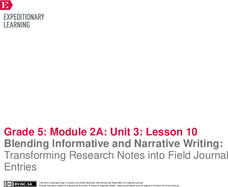Curated OER
Basic Life Support System
In this life support worksheet, 7th graders study botany and soil. Students complete a given task and show results on the 2 graphic organizers provided.
Curated OER
What is the Solar System?
Students study the solar system. In this solar system instructional activity, students create graphic organizers, and participate in class demonstrations illustrating size and distance within the solar system.
Curated OER
Characteristics of Materials
In this materials characteristics worksheet, students complete a graphic organizer, filling in the following categories for objects found at school or home: object, its use, material made from and why that material is a good choice.
Curated OER
Condense, Combine, or Categorize New Information - Your Brain and Moral Decision-Making
Students condense information and create a summary paragraph on a video segment. In this brain activity lesson, students watch a video that chronicles an experiment in how the brain responds when making moral decisions. Students use a...
Curated OER
Dark Nights-Nature Notebook
In this night time worksheet, students complete a graphic organizer about the night, drawing and filling in information about the night sky, the night ground, and the lights they may see.
Curated OER
Good Bug Survey
In this bug survey worksheet, students fill in squares on a graphic organizer with information about flowers currently blooming, hiding places for "good bugs," and any bugs they have seen that are helpful for pollination, as food for...
Curated OER
Native or Not?
In this Ranger Rick activity, students read a Ranger Rick articles and complete a graphic organizer that requires them to compare invasive and native species. The article is not included.
Curated OER
Butterflies A-Flutter
In this butterfly worksheet, students read about butterflies, then complete a graphic organizer, drawing pictures of 2 different butterflies, using a table of "stay-safe" butterfly tricks to help complete the chart.
Curated OER
Amphibians: Frayer Model
In this amphibians worksheet, students complete the Frayer model graphic organizer for amphibians. Students write down definitions, characteristics, examples, and non examples.
Curated OER
Cell Type
In this cells worksheet, students complete a graphic organizer where they fill in boxes for the cell type they are researching. Students complete boxes for characteristics, examples, non examples, and a definition.
Curated OER
Imagery Chart
In this imagery worksheet, students fill in the graphic organizer with the five senses that they observe. Students complete 5 sections.
Curated OER
The Shape of Things
Fourth graders develop their writing skills. In this paragraph structure lesson, 4th graders research natural disasters, compile their findings, create mobiles and write stories based on the mobiles.
Consortium for Ocean Science Exploration and Engagement (COSEE)
Understanding the Food Web
Building on prior knowledge of the pervious lesson in the series, pupils explain the previous lesson to each other. Then they write a simple guide for a young child to read on the same topic.
Biology Junction
Biochemistry of Cells
Chemistry and biology work hand in hand, without one you literally wouldn't have the other. Using a presentation, individuals learn about plant cells, animal cells, cell responses, macromolecules, DNA bases, and so much more. A worksheet...
Curated OER
Caterpillars and Climate: How Temperature Affects Feeding Rate In Insects
Do you eat more when you are hot or when you are cold? Young scientists observe the eating pace of two caterpillars at different temperatures. The differences in endotherm and ecotherm animals' ability to adjust to temperature change...
Science 4 Inquiry
The Ins and Outs of Photosynthesis
The most important chemical process on Earth is photosynthesis. Scholars explore the changes in the gases in our atmosphere as life on Earth developed. They create a model of photosynthesis and consider simple questions.
Science 4 Inquiry
The Ups and Downs of Populations
As the reality of population decline across many species becomes real, pupils learn about the variables related to changes in populations. They complete a simulation of population changes and graph the results, then discuss limiting...
EngageNY
Blending Informative and Narrative Writing: Transforming Research Notes into Field Journal Entries
The fabulous four. Scholars learn the four key components for creating an excellent journal entry. They then work to create a journal entry rubric and participate in a mini lesson about organizing and outlining journal entries.
CK-12 Foundation
Cannon Simulation
Fire in the hole! Thrill your classes as they see what it's like to fire a cannon ball. Scholars practice aiming a cannon ball by altering first the firing angle, then the velocity, and finally both simultaneously. Can they discover the...
Curated OER
Webbing out Electricity
Fourth graders identify electricity as a form of energy that is associated with common household products. They utilize technology as an aid in which they can graphically organize their thoughts.
Curated OER
Inventions
Students develop an intervention and write a short paper on its uses and applications. They use a graphic organizer to prewrite and take their work through all steps of the writing process.
Curated OER
Mystery Paint
Students use the scientific method to determine the properties of various kinds of paints, use collected data to identify paint samples that are not properly labeled and use proper science safety techniques while working with chemical...
Curated OER
Element Research Project
Students research elements on interactive Internet periodic tables, take notes using Inspiration software, and write descriptive paragraphs with graphics. They create presentations.
Curated OER
What's the Matter? (Grade 3)
Third graders organize information about the three types of matter and to reinforce concepts learned in the matter unit of the science curriculum. They use Inspiration software to create a concept map of the three types of matter.

























